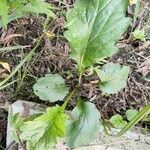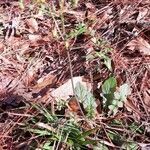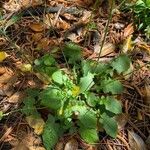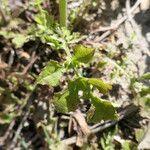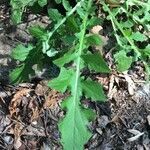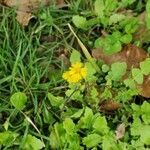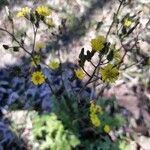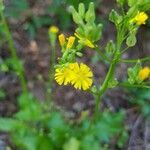Herbs usually 10-150 cm tall, annual. Stems solitary or few, erect, branched from base, middle, or only apically, glabrous or basally often ± hairy, ± leafy or leafless. Basal leaves ± oblanceolate, to 15(-25) × 4(-6) cm, lyrately pinnatipartite or pinnatisect, rarely not divided; glabrous or somewhat hairy, base attenuate into a longer or shorter narrowly winged to ± unwinged petiole-like portion, margin sinuate-dentate; lateral lobes few to many, ovate, rhombic, or elliptic, gradually smaller toward leaf base; terminal lobe ovate, ovate-lanceolate, or obovate, much larger than lateral ones, apex rounded to acute. Stem leaves similar to basal leaves, abruptly or gradually reduced to bracts upward on stem. Synflorescence corymbiform to paniculiform-corymbiform, usually with many to numerous capitula. Capitula with 10-20 florets; peduncle capillaceous. Involucre cylindric, 4-7 mm. Phyllaries abaxially glabrous; outer phyllaries ovate to triangular, longest less than 1.5 mm, apex acute; inner phyllaries adaxially appressed pubescent, midvein subapically plane, margin ± white scarious, apex acute. Anther tube dark green. Style branches yellow upon drying. Achene light brown to dark reddish or purplish brown, fusiform, 1.5-2.5 mm, ribs finely spiculate, apex strongly attenuate. Pappus white, 2.5-3.5 mm. Fl. and fr. Feb-Dec.
Scapose or scapiform annuals to c. 0.6 m high, with spreading coarse hairs scattered or sparse on stems and leaves. Basal leaves to c. 20 cm long, with l:w ratio 3–8, often lyrately divided, petiole-like basally, entire, denticulate or dentate; cauline leaves few, similar to basal leaves or much reduced, undivided. Capitula several–many; involucre 4–5 mm long, c. 1.5–2 mm diam.; outer bracts 3–5, ovate, 0.5–1.0 mm long, with broad hyaline margin; inner bracts 7–10, 4–5 mm long, with a prominent pale keel developing basally, with hyaline margin alternately distinct and vestigial. Florets: ligule c. 3 mm long, yellow, possibly rarely white; style hairs pale. Achenes narrowly ellipsoid, 1.5–2 mm long, slightly to moderately compressed, tapering to a neck c. 0.2 mm long, with ribs crowded, unequally prominent, ciliate, with cilia longer distally, reddish brown or mid-brown. Pappus c. 3 mm long, white; bristles barbellate proximally.
Stems terete, fistulose. Leaves: petioles 1–10 cm, glabrous, puberulent, or densely hairy (hairs often brownish, crinkled); blades 3–12(–25) × 2–4(–6) cm, lateral lobes 0–20, mostly gradually reduced proximally, terminal lobes elliptic, ovate, obovate, or oblong-truncate, larger than laterals, apices obtuse or acute. Peduncles 1–5(–15) mm. Phyllaries 3.5–6 mm, bases and midribs becoming ± spongy, abaxial faces glabrous, glabrate, or hairy (hairs appressed, shining). Florets: corollas mostly 4.5–6.5 mm; anthers dark green (drying purplish); styles and style-branches yellow. Cypselae 1.5–2.5 mm, bases hollow, lightly calloused; pappi 2.5–3.5 mm, slightly surpassing phyllaries. 2n = 16.
An annual herb up to 45 cm tall, glabrous or sparsely hairy, flowering stems one or several from the crown, nearly nude, corymbosely branched above, the ultimate branches filiform. Leaves mostly radical, up to 25 x 8 cm, but often much smaller, obovate in outline, petiolate, sinuate-toothed or runcinate-pinnatifid, thin-textured. Heads many, very small. Involucre up to 5 x 2 mm, the inner bracts of fruiting heads with the midrib thickened in the lower part. Flowers yellow. Achenes elliptic, slightly compressed, scarcely beaked, ribbed, minutely hispid on the ribs, pale brown.
Polymorphic, subscapose annual 1–9 dm, scabrous or ± hairy toward the base; lvs mainly or all basal, mostly lyrate-pinnatifid, or subentire in small plants, up to ca 20 × 6 cm; heads small, numerous in a corymbiform or paniculiform infl; fls ca 10–20, the tube ca 1/4 as long as the ligule; invol 3.5–5 mm, glabrous, with 4 short outer and ca 8 longer inner bracts; achenes brownish, 1.5–2.5 mm; pappus 2.5–3.5 mm; 2n=16. Native to se. Asia, now a pantropical weed, and becoming common on the coastal plain in se. U.S., n. to Pa. (Crepis j.)
An erect annual herb. It grows to 60 cm high. The leaves normally form a rosette or ring near the base. They are 5-10 cm long. Leaves on the stem are smaller. The sap is white and milky. The flowers occur in heads of about 20 flowers on an almost leafless stalk. The flowers are yellow. The fruit is round in cross section and flat at the top.
